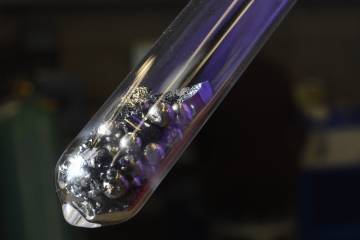Johns Hopkins' groundbreaking bulk crystal growth facility, part of one of four materials innovation platforms supported by the National Science Foundation, has received a $5 million renewal grant that will allow scientists to continue designing and creating new materials there for the next generation of electronic devices.
The award—$22.5 million in total—funds a second five-year period for the effort: Platform for the Accelerated Realization, Analysis, and Discovery of Interface Materials, or PARADIM. Designed to enable users to discover, develop, manufacture, and deploy advanced materials more quickly and affordably than conventional methods allow, PARADIM also includes partners at Cornell, Princeton, and Clark Atlanta universities.
With the renewal, Hopkins' crystal growth facility will continue offering scientists, engineers, and entrepreneurs from around the country the tools, techniques, and expertise to realize materials with unique properties for use in applications like computation, low energy sensors, and security devices. The renewal will also allow the facility's users to apply advances in artificial intelligence and machine learning to quantum materials discovery. In its first five years, PARADIM hosted more than 170 users from 41 universities and national labs.
"PARADIM is not just a place where you send requests for new materials and we make them; instead, users come to the platform and work side by side with our experts to take new materials and technologies from idea to realization," says Tyrel McQueen, professor in the departments of Chemistry and Physics and Astronomy, and director of the crystal growth facility. "This is a new way of doing materials research, one that realizes new technologies and trains an expanded workforce to tackle a lifetime of materials challenges to improve society."
In addition to being a national user facility, PARADIM hosts a graduate traineeship program that provides students a one-of-a-kind opportunity to develop skills in all aspects of materials discovery, preparing them as part of the next-generation workforce. Hopkins piloted these traineeships in the first funding cycle, and the renewal allows slots at Hopkins to double to four—and allows Cornell to create seven slots—with an emphasis on underrepresented students.
Meanwhile, 47 students have participated in PARADIM's Research Experiences for Undergraduates program, in which students work on independent research projects supporting PARADIM's mission. The platform also offers a popular weeklong summer school program that has trained 230 people, many of whom have returned as PARADIM users.
Research at PARADIM has resulted in 140 journal publications to date. Among the platform's most notable discoveries are a new ultrawide bandgap semiconductor, a new type of topological insulator, and a form of galfenol that is the world's highest performance magnetostrictive material—a material consisting of tiny ferromagnets that can change its shape during magnetization—free of rare earth elements.
"PARADIM is creating a new model for materials research," says Charles Ying, the NSF program officer who oversees the platform. "Users throughout the country and scientists at Cornell University and Johns Hopkin University not only benefit from the state-of-the-art and often unique instruments, but also share technical know-how and data for a common goal of speedy design and creation of novel materials."









